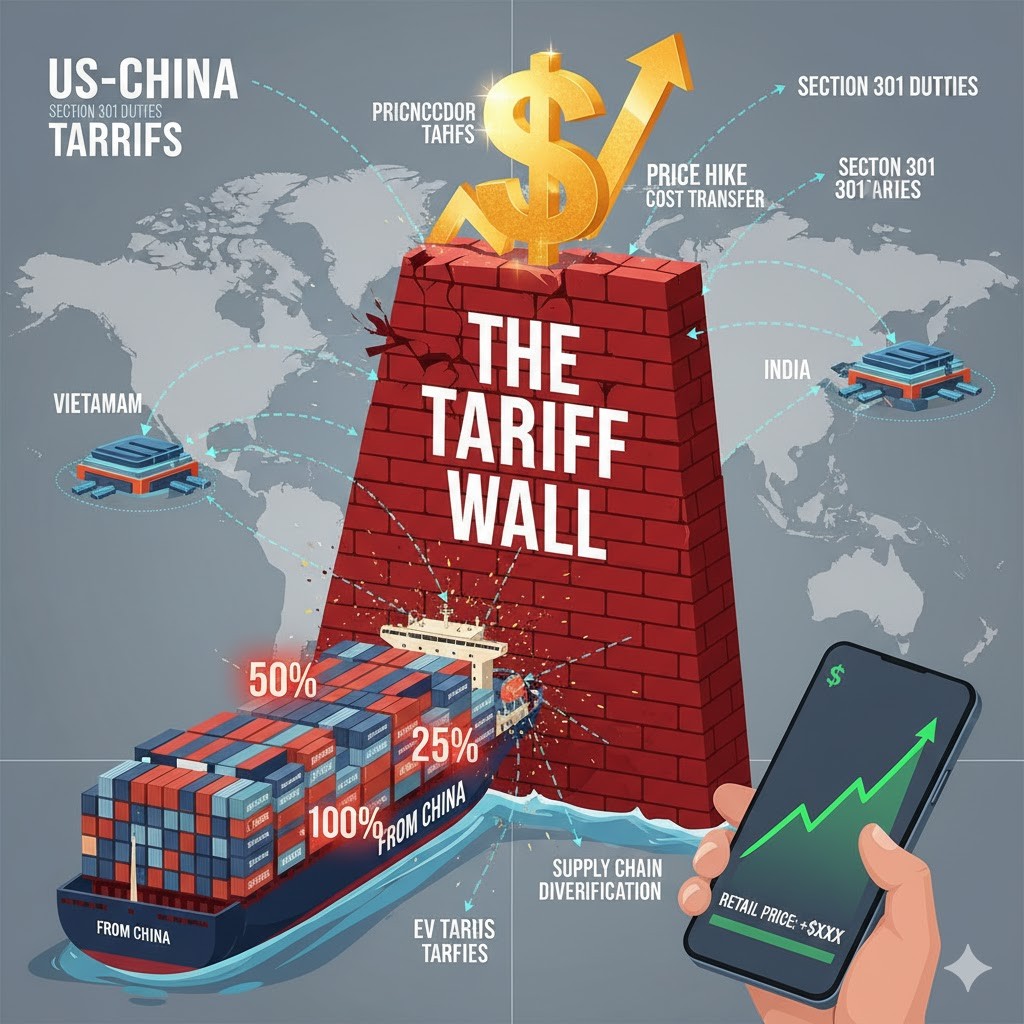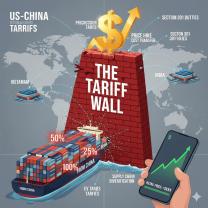The global electronics trade has been fundamentally reshaped by the geopolitical tensions and resulting tariff actions between the United States and China. What began in 2018 as a series of Section 301 tariffs aimed at addressing China's acts, policies, and practices related to technology transfer, intellectual property, and innovation, has evolved into a persistent and complex trade environment for importers. These duties have created significant friction, driving up costs, disrupting finely tuned global supply chains, and influencing investment decisions worldwide.
Electronic products, ranging from everyday consumer devices like smartphones and laptops to critical industrial components such as semiconductors and printed circuit boards, quickly became a major focus of these U.S. import tariffs.
This article provides a data-driven analysis of the current tariff rates impacting Chinese electronics, outlines the most affected product categories, and explores the resulting influence on consumer prices. We will also examine the emerging tariff trends for 2025 based on ongoing policy reviews and detail the mechanisms through which businesses can seek tariff exemptions for electronics to mitigate their exposure. Staying informed on these evolving US tariff rates on Chinese electronics is crucial for businesses operating in this high-stakes sector.
What Are the Current US Tariff Rates on Chinese Electronics?
The vast majority of customs duties on electronics imported from China are levied under Section 301 of the Trade Act of 1974. These are additional ad valorem duties applied on top of the standard Most-Favored-Nation (MFN) tariff rates, which average around 3.3% for all goods but are often 0% for many electronics.
The current landscape is characterized by the continuation and, for some strategic sectors, a substantial escalation of these tariffs following the U.S. Trade Representative's (USTR) four-year review.
Key Tariff Percentages and Affected Sectors
As of late 2025, the Section 301 tariffs are tiered, with the most significant increases targeting high-value, strategic technology products, often identified by their Harmonized Tariff Schedule (HTS) codes:
Semiconductors and Integrated Circuits (HS Chapter 85): The additional tariff rate for semiconductors is set to increase substantially, with some categories reaching 50% (up from a previous rate of 25%) effective January 1, 2025.
This aims to protect U.S. chip manufacturers and reduce reliance on Chinese legacy chips. Electric Vehicles (EVs): A sharp increase to 100% (up from 25%) was implemented on September 27, 2024, essentially closing the U.S. market to direct imports of Chinese-made passenger EVs.
Lithium-ion Batteries for EVs: Tariffs increased to 25% (up from 7.5%) on September 27, 2024, and are scheduled to increase further to 25% on non-EV lithium-ion batteries starting January 1, 2026.
Solar Cells and Modules: The tariff on these renewable energy electronics increased to 50% (up from 25%) on September 27, 2024.
General Consumer Electronics (e.g., Laptops, Smartphones, Circuit Boards): Many items under List 3 and 4A have a current additional duty of 7.5% to 25%.
While some of these rates were temporarily lowered during a trade truce period, the underlying Section 301 action remains in place, often adding a significant duty layer to categories like HTSUS 8471 (computing machines) and related components.
The additional tariffs are additive, meaning an importer must pay the standard MFN rate plus the Section 301 duty. The continuation and modification of these Section 301 tariffs under the current administration underscore a sustained commitment to industrial and national security policy goals.
Which Electronic Products Are Affected the Most by Tariffs?
The product groups facing the highest import duties are those deemed strategically important for future economic and military technology dominance, though the impact also extends heavily into mass-market consumer goods.
Highest-Duty Product Groups
| Product Group | Examples (HTS Subheadings) | Additional Section 301 Duty (Approximate) | Impact Rationale |
| Semiconductors & Components | Certain memory chips, integrated circuits (HTSUS 8542) | Up to 50% (Effective Jan 1, 2025) | Critical for national security, AI, and industrial policy. |
| EV & Energy Electronics | Electric Vehicles (EVs), EV Li-ion batteries (HTSUS 8703, 8507.60) | 100% (EVs), 25% (EV Batteries) | Protection of the emerging U.S. domestic EV and clean energy industry. |
| Solar & Photovoltaics | Solar cells, modules (HTSUS 8541.40) | 50% | To combat perceived overcapacity and unfair competition in the solar sector. |
| Industrial & Telecom Gear | Telecom equipment, certain PC components, networking gear (Various) | 7.5% to 25% | Broad-based tariffs affecting corporate and infrastructure technology costs. |
| Consumer Electronics | Laptops, Tablets, Smart Home Devices (HTSUS 8471) | 7.5% to 25% | Wide-ranging impact due to China's dominant manufacturing role. |
Sectors like high-end telecom gear, specialized PC components (e.g., motherboards, graphics cards), and sophisticated smart home devices have been significantly exposed. These duties have catalyzed a demonstrable supply chain shift toward alternative sourcing locations.
How Do Tariffs Influence the Price of Consumer Electronics?
Tariffs are essentially a tax on imported goods, and their effect on pricing is generally one of increased costs for American consumers and businesses.
Tariff Pass-Through and Retail Price Markups
Importers face an immediate increase in the landed cost of goods due to the added customs duties on electronics. While some companies absorb a small part of this tax through reduced profit margins, the majority is typically factored into the final retail price.
Direct Cost Increase: Studies indicate that for tariff-sensitive goods, including electronics, between 61% and 80% of the new tariff cost is passed through to consumer core goods prices.
Examples of Markups: Reports evaluating the impact of these tariffs on consumer technology products have projected significant potential price increases for goods almost entirely sourced from China.
For instance, without a tariff exemption, items such as laptops and smartphones could see markups ranging from $100 to $300 or more, depending on the retail price and the final effective tariff rate. Gaming consoles, another category with heavy Chinese manufacturing reliance, have also faced pressure. Competitive Effects: Tariffs also create pricing power for domestic competitors or importers sourcing from non-tariff countries. This allows them to raise their prices as well, even without a direct cost increase, which further contributes to overall inflation in the electronics category.
To mitigate this pass-through, some large Original Equipment Manufacturers (OEMs) have invested heavily in relocating assembly operations out of China, accepting the high upfront cost of building new factories in Southeast Asia or Mexico to avoid the recurring electronics import tariffs 2025.
What Are the Tariff Trends for 2025 in the Electronics Sector?
The electronics import tariffs 2025 are subject to significant trade policy reviews and geopolitical factors, but the overarching trend points toward continued high tariffs, particularly in strategic technology sectors.
2025 Projections and Policy Drivers
Sustained Strategic Tariffs: The USTR's actions have focused on increasing duties on semiconductors (50%), EVs (100%), and batteries (25%+).
This indicates a long-term policy goal of protecting nascent domestic industries like those supported by the CHIPS and Science Act and the Inflation Reduction Act (IRA). These high rates are unlikely to be reduced soon. Uncertainty in Mass-Market Goods: For general consumer electronics (laptops, phones), the prevailing 7.5% to 25% rates are subject to political negotiation and ongoing trade reviews. While a temporary truce or short-term tariff reduction has occurred in the past, a full repeal is considered highly improbable given the current political climate. The default trajectory is the maintenance of the current Section 301 tariffs.
Global Demand Influence: The insatiable global demand for advanced chips, AI hardware, and EV components will play a role. If U.S. domestic supply or alternative third-country supply cannot meet demand, policymakers may face pressure to offer targeted tariff relief to prevent severe supply shortages or crippling cost increases for downstream U.S. manufacturers.
Bilateral Negotiations and USTR Reviews: The results of ongoing USTR statutory reviews and any future high-level bilateral negotiations will ultimately determine the definitive US tariff rates on Chinese electronics post-2025. Businesses must track official Federal Register notices and USTR press releases closely.
Can Businesses Apply for Tariff Exemptions on Electronics?
Yes, businesses can and do apply for temporary relief from the Section 301 tariffs through the USTR's tariff exclusion process.
The USTR Tariff Exclusion Process
The USTR allows interested persons to submit requests for temporary exclusion of specific products from the Section 301 tariffs.
Key Eligibility Criteria and Documentation:
Unavailability: The most critical factor is proving that the electronic item, or a comparable item, is not available from domestic sources or third countries (e.g., Vietnam, Mexico). Businesses must document their efforts to source alternatives.
Impact on U.S. Operations: Applicants must demonstrate that the tariff is causing severe economic harm to the business or its downstream U.S. customers.
Strategic Importance: The request must show that granting the exclusion would not undermine the objectives of the Section 301 investigation (i.e., that the product is not related to strategic Chinese industrial programs like "Made in China 2025").
Product Specificity: Requests must include a complete and detailed description of the product, including its 10-digit HTSUS subheading and physical characteristics, ensuring it is precisely defined.
Guidance for Businesses:
Monitor USTR Dockets: Stay informed about new or re-opened exclusion request periods, such as those recently announced for "certain machinery used in domestic manufacturing" (HTSUS Chapters 84 and 85).
Detailed Documentation: Gather comprehensive evidence of sourcing attempts, including quotes from non-Chinese suppliers and technical specifications that prove the Chinese-made component is unique and indispensable.
Compliance Best Practices: Even with an exemption, businesses must adhere to strict U.S. Customs and Border Protection (CBP) guidance, ensuring proper documentation and accurate classification of goods. Exclusions are not retroactive and are only valid for a specified, often short, time frame.
The tariff exemptions for electronics are product-specific and temporary, but they offer a vital avenue for companies that face unique supply chain challenges and cannot immediately shift sourcing.
FAQ Section
What is the Section 301 tariff list?
The Section 301 tariff list is a series of lists (originally List 1, 2, 3, and 4A) of products imported from China that are subject to an additional ad valorem duty imposed by the U.S. government.
Are smartphones currently subject to U.S. import tariffs?
Yes. Smartphones (typically classified under HTSUS 8517.12) are generally subject to a Section 301 tariff rate, which has fluctuated but often falls within the 7.5% to 15% additional duty range (on top of the standard MFN duty). While some tariffs on consumer items were initially delayed or excluded, the majority of mass-market electronics manufactured in China now face this added cost burden.
How can companies reduce tariff exposure when sourcing from China?
Companies can reduce their tariff exposure through several strategies:
Supply Chain Diversification: Shifting production and sourcing to countries not subject to the Section 301 tariffs (e.g., Vietnam, Mexico, Malaysia, India).
Tariff Engineering: Adjusting the product's design, manufacturing process, or final assembly location to change its country of origin or HTS classification to one not subject to tariffs.
Tariff Exclusion Requests: Applying to the USTR for a specific, temporary tariff exemption for electronics if the product is proven to be unavailable outside of China.
First Sale Rule: In some cases, structured transactions can potentially lower the customs valuation on which tariffs are calculated, though this requires strict adherence to CBP rules.
Conclusion
The high US tariff rates on Chinese electronics continue to be the dominant factor shaping the trade relationship between the two economic giants. By imposing Section 301 tariffs that reach up to 100% on key sectors like EVs and 50% on semiconductors, the U.S. has clearly signaled a commitment to prioritizing national policy goals of technology security and supply chain independence over immediate cost considerations.
The direct result is that customs duties on electronics are leading to higher retail prices for American consumers and increased operating costs for U.S. businesses.



TradeAnalyst47
on October 15, 2025The projected 50% tariff on semiconductors, effective 2025, is a game-changer. It forces an immediate reassessment of every tech BOM relying on Chinese legacy chips.